'It's coming': Asheville Amtrak feasibility study brings calls for funds, advocacy
ASHEVILLE - While attending summer camp at Camp Ridgecrest in 1962, Steve Little would stay up late, struggling to sleep through the night. In the distance, and through a symphony of crickets, he could hear something: the sound of a distant train.
"It's going slowly and down shifts," Little said. "And that sound — I still remember that. And I used to imagine: 'Where has that train been?' and 'Where is it going?'"
"'Is it carrying people, or is it carrying freight?'"
For Little, a long-time rail advocate and historian, and current mayor of Marion, this question has been easy to answer for nearly 50 years. It only could be freight — Western North Carolina doesn't have passenger rail, at least not anymore.
In 1975, the last passenger train left Asheville's Biltmore Station and didn't return. However, in 2023, the tracks switched in a new direction.
The recent, revitalized effort to restore passenger rail to WNC comes with the Dec. 8 release of the finalized feasibility study from the North Carolina Department of Transportation and $500,000 in federal funding.
In the study, the upper estimate for ridership is 550,000 people a year, which alone could bring a yearly total of nearly $10.9 million in fare revenues.
"It's still going to be — by one credible source — seven years before you should ever start to think there is going to be a train on the track," Little said. "But it is coming."
N.C. Department of Transportation Rail Division Director Jason Orthner and Little attended the Dec. 11 grant ceremony held at Raleigh Union Station. Orthner told the Citizen Times that the final study and federal funding come as statewide efforts for a stronger rail network increase.
"What we are trying to do is create a North Carolina wide system, where people have access to a really high quality passenger rail system," Orthner told the Citizen Times.
The demand for an Asheville Amtrak line is underscored by the fact that several of the few — and possibly only, according to Little — grassroots regional rail advocacy groups in North Carolina are from WNC.
The WNC Rail Committee is one of those groups, of which Little serves as co-chair along with Ray Rapp, a former Democratic state legislator. Orthner said the committee is a prime example of "what the department likes to see."
"We can't do a top down approach to transportation," Orthner said. "It really works best when it comes from the folks that are the users of that transportation asset that we're looking at putting in. The WNC Rail Committee understands transportation and understands what rail does for WNC."
For rail in WNC, the federal grant marks a step forward, and is similar to "where the Raleigh to Richmond project was" years ago, Orthner said. A $1 billion grant toward expanding the "S-Line" service between Raleigh and Richmond was announced alongside the seven exploratory North Carolina passenger rail corridor grants.

The Corridor ID program is a pipeline "so a project can continue to advance on the development phase," Orthner told the Citizen Times.
"The Corridor ID program is an acknowledgment by the FRA that the corridors that were selected are ready to move into a development process, which includes identifying service characteristics — like how many trains would operate at what times in close coordination with the railroad," he said.
The line was added to Amtrak's Connect US plan in 2021. The addition was followed by the July 2021 passage of the American Jobs Plan, which included $61 billion toward new rail projects.
Why Salisbury? 'Center of WNC Rail history'
The Salisbury line was chosen over alternatives to Charlotte or Raleigh for the line's existing elements, which would be "the most logical and quick way to get WNC connected to a robust rail system," Orthner said.
"You know, we'll continue to look at the network as we go forward, but what we are trying to do is find a project where we can deliver services in the fastest possible way," he said of the Salisbury location.
The history of the Salisbury depot is much deeper, however.
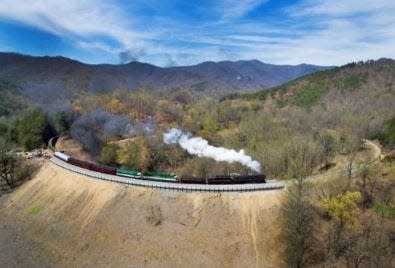
Beginning in the 1830s, WNC was already on the map to receive rail service, Little said. That's when some of the first discussion of a Salisbury-to-Asheville depot started.
"The point where the legislature chose to branch off from the crescent-shaped North Carolina Railroad to form the WNC Railroad was at Salisbury — in the middle of the state, basically," Little said. "That's why that railroad is located where it is."
The construction of the Western North Carolina Railroad line has a storied history. One of the most complex sections of the railroad is rooted in Jim Crow laws that allowed the state-owned WNC Railroad to use Black prisoners on its construction crews.
This section of the line, known as the "Old Fort Loops," was created through the forced labor of Black prisoners, and led to the creation of the work song "Swannanoa Tunnel," which depicts the violent and deadly construction of the 1,823-foot railroad tunnel.
"In doing research, I even have located some articles that were in newspapers in the eastern part of North Carolina, talking about the need for the sheriff to arrest more people — Black people — and for the judges to convict them and send them to the penitentiary so they can be shipped up to the mountain to work on this railroad," Little said of the history of the loops.
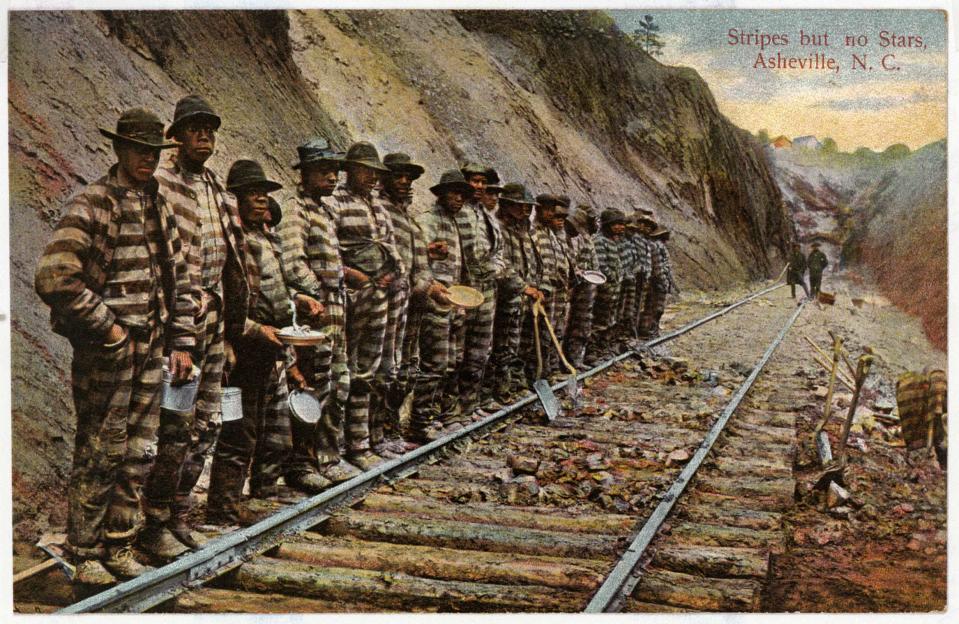
Often or always working under gunpoint, an estimated 125-300 died in the construction of the line, according to The RAIL Project, of which Little serves as a member of the board of directors along with Dan Pierce, Ph.D, the UNCA Asheville Mountain South Distinguished Professor of History, who have worked together to honor the efforts of those who were forced to work on the railroad.
Little said the Old Fort Loops are known to rail enthusiasts "not only throughout the United States but in other countries as well."
"Old Fort is the center of the universe of railroad history in WNC," he told the Citizen Times.
2022 article on the RAIL project: Forced convict labor on NC railroad in 1800s left behind 'mass grave'; memorial in works
'Waiting for a Train'
In October, nearly 66,000 passengers rode the NC by Train service provided by the North Carolina Department of Transportation, the single highest monthly ridership recorded by NCDOT.
In that time, a yet-to-be-published ridership study has indicated Asheville as the most requested location not currently on the NC by Train Amtrak service, according to Orthner.
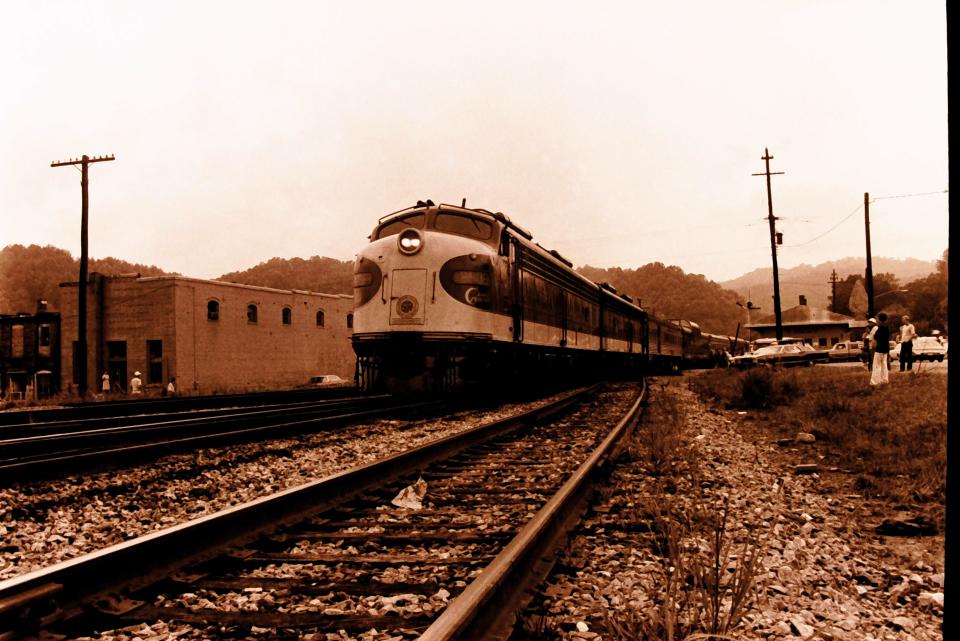
The study reflects recent regional efforts for the project.
In Morganton, a recent grassroots effort to return rail to the town of nearly 20,000 started with a discussion about "how great it was it hear a train whistle at night," said Mimi Phifer, who founded Morganton-based train advocacy group Waiting for the Train alongside her neighbor Barbara Lynam.
The group's name is a nod to the Jimmie Rodgers song titled "Waiting for a Train."
"We were just talking about how wonderful passenger trains used to be, and we decided then that we were going bring passenger train back to WNC, but of course we didn't have the foggiest idea how to do that," Phifer told the Citizen Times.
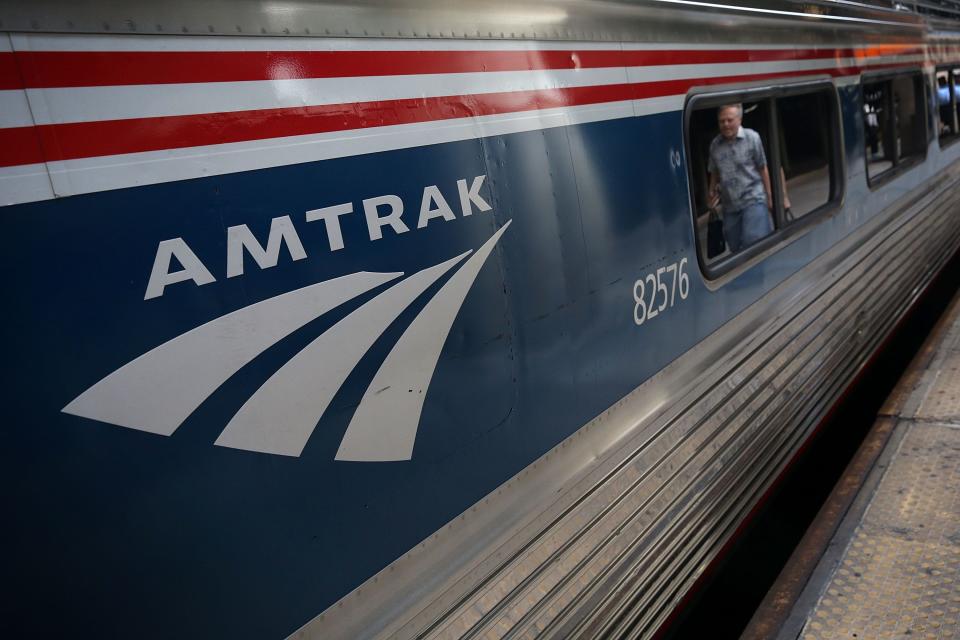
Starting as a meeting of five on Lynam's front porch in September 2023, Waiting for the Train has grown fast. A November event at the Morganton train depot received attention from regional leaders and tallied around "250 people in 30-degree weather outside at night."
The event was attended by State Rep. Hugh Blackwell and State Sen. Warren Daniel, N.C. state House Speaker Tim Moore called into the event, proclaiming his support for the rail project. Moore, a Republican, is running for U.S. House in the recently reconfigured 14th Congressional District.
Orthner believes another next step is working with the communities invested in the project along the line — communities like Morganton.
"It's critically important for us to work with these communities and make sure that their access to the network is done really well," he said.
"We have a whole process that we've been working on that we developed on the S-Line with communities to make sure that they're thinking about the station locations and the development opportunities around them."
For Phifer and Lynam, they're excited to connect with those who are interested in working together to advocate for the stations.
"I've been trying to figure out how to meet up with other people in other towns down the line," Phifer said.
"We joined to work on this just as long as we're having fun. This is something fun and exciting, and we are hopeful," Lynam said.
You can learn more about Waiting for the Train at https://www.morgantonpassengertrain.com/.
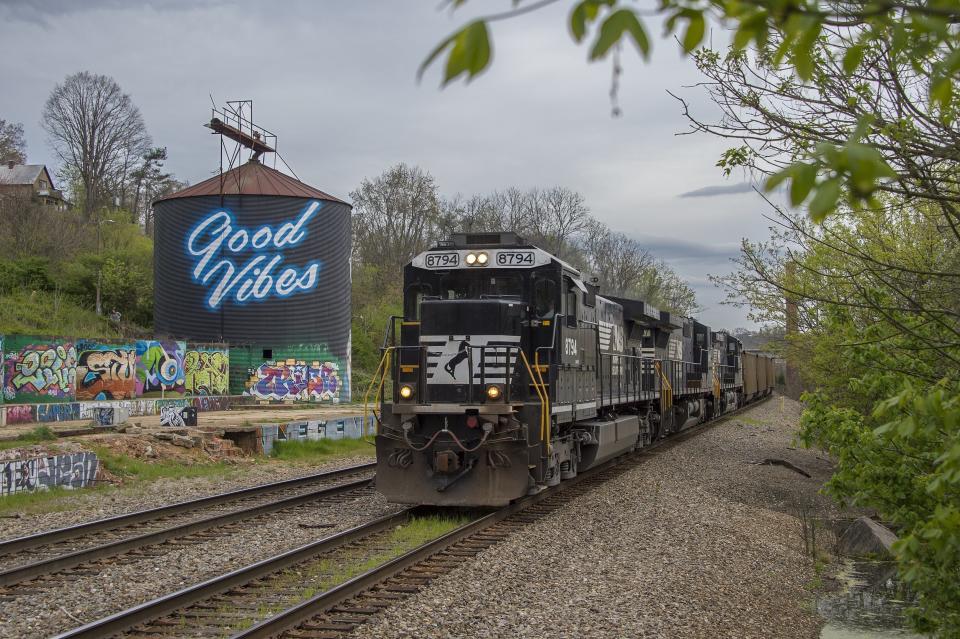
Norfolk Southern: 'I cannot overstate how important their role is'
Norfolk Southern, the owner of the Salisbury to Asheville rail line, will play a key role in permitting the use of passenger rail on their tracks. A letter from the railroad, dated Aug. 3, is included in the final draft of the report noting the feasibility study does not include the railroad's input.
"NS does support the expansion of passenger rail service in North Carolina and elsewhere. That expansion, of course, needs to be done so that the passenger service expansion is transparent to our current and future freight and intercity passenger operations. Expansion contemplated by the Report could only be effectuated after study and agreement with NS," the letter reads.
More: 'Most requested location': Asheville most desired city for NC Amtrak stop: NCDOT study
For NCDOT, the railroad's collaboration in this effort is vital.
"I cannot overstate how important their role is," Orthner said of Norfolk Southern.
"This corridor ID process will take us into a much more formal coordination with Norfolk Southern to make sure that as we're developing this corridor that we are ensuring that the important freight that operates over the same corridor, that capacity is preserved and opportunities for expansion of those services are preserved as well," Orthner told the Citizen Times.
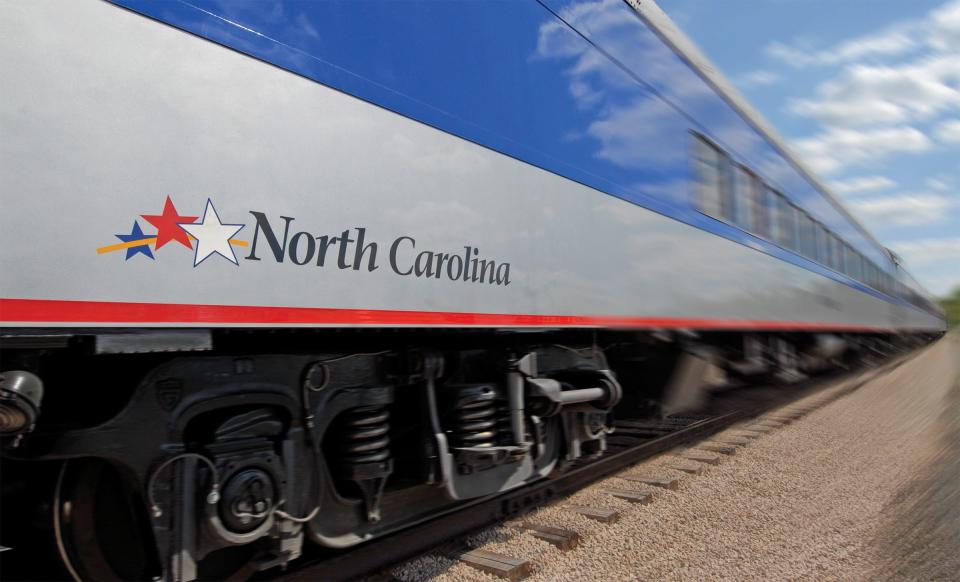
'Though my pocketbook is empty...'
While the $500,000 toward the Salisbury-Asheville line will set the line on the "pipeline" to being federally funded, North Carolina advocates will still have to fund some of the estimated $665 million price tag.
Earlier this month, Ray Rapp, co-chair of the WNC Rail Committee, spoke with the Citizen Times about funding for the project, encouraging collaboration between regional leaders and interest groups.
"They're going to have to come up with 20% of this money through a number of different sources. This is why we're going to have to organize the stakeholders groups; the mayors, the county commissioners, the regional economic development groups," Rapp said.
The one big holdout? Rapp and Little said they are still to hear from U.S. Rep. Chuck Edwards on proposal, who expressed reservations on rail in the region earlier this year.
Little said if Edwards doesn't have a stance yet, he hopes to meet with him to discuss the project further.
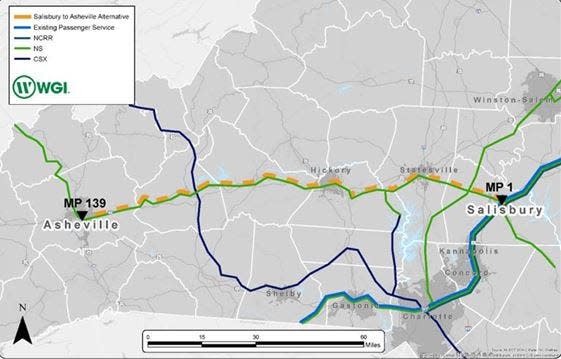
Travel estimates? How much? Where are the stations? What to know
While stations are not strictly outlined in the feasibility study, a few historic and renovated depots housing "interim compatible uses" in Conover, Marion, Morganton, Old Fort and Statesville are mentioned.
While past studies have considered a Valdese stop or a Black Mountain stop, Little said he feels it is "unlikely" Black Mountain would be chosen as it is "only 20 minutes from Asheville."
The finalized study comes with an estimate of travel times between Asheville and Salisbury, along with travel estimates to Raleigh and Charlotte. Each train travel estimate includes a minimum of 30 minutes to allow for train transfers. The fare is currently estimated to cost $24 but could change as it's set in 2023 pricing assumptions.
Here are the estimates for the Salisbury to Asheville travel times.
Salisbury to Asheville
Train: 3 hours and 35 minutes
Car: 2 hours and 10 minutes
Bus: 3 hours and 30 minutes
Raleigh to Asheville
Train: 6 hours and 47 minutes
Car: 3 hours and 50 minutes
Bus: 6 hours and 20 minutes
Charlotte to Asheville
Train: Four hours and 26 minutes
Car: Two hours and 10 minutes
Bus: Two hours and 55 minutes
More: No longer a 'distant dream,' Asheville vies for return of passenger rail services to WNC
More: Opinion: Asheville has a chance to bring back Amtrak passenger train system
More: Asheville Amtrak train line proposal advanced by NC transportation department
Will Hofmann is the Growth and Development Reporter for the Asheville Citizen Times, part of the USA Today Network. Got a tip? Email him at WHofmann@citizentimes.com.
This article originally appeared on Asheville Citizen Times: Asheville Amtrak study released; Why Salisbury? What's next WNC rail?

